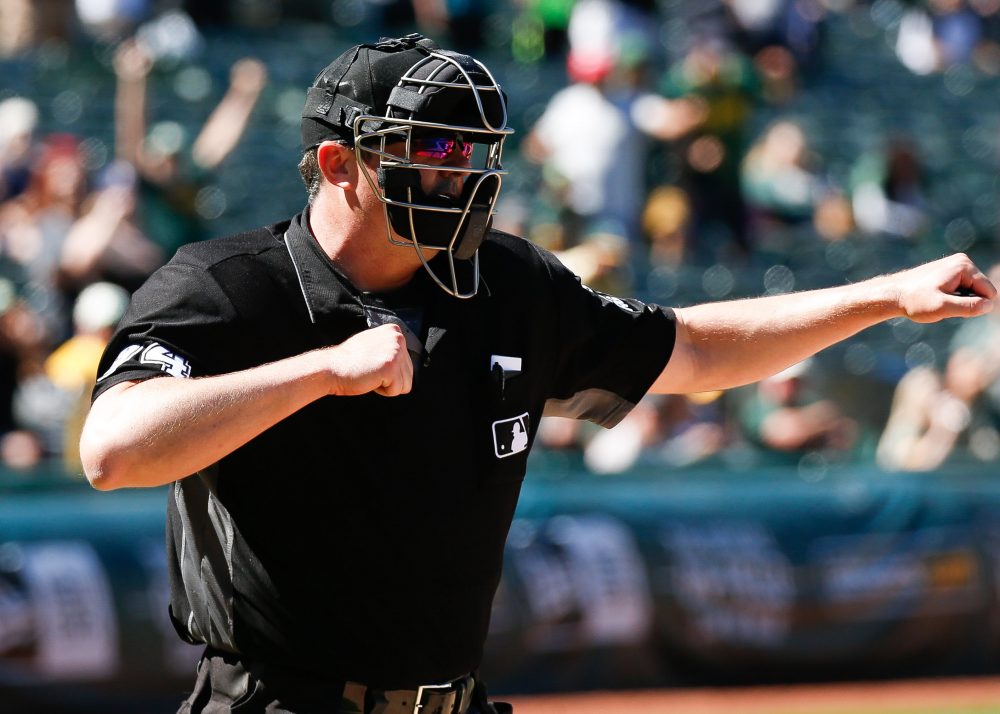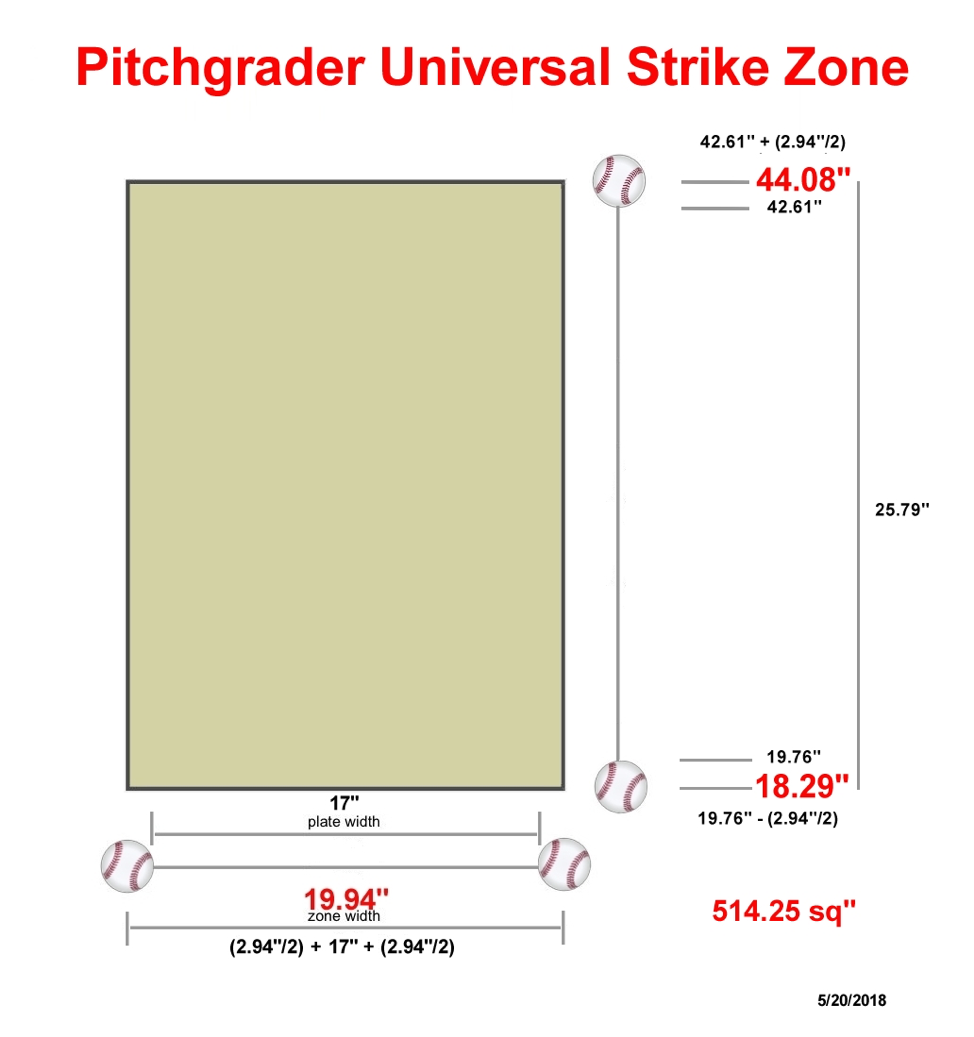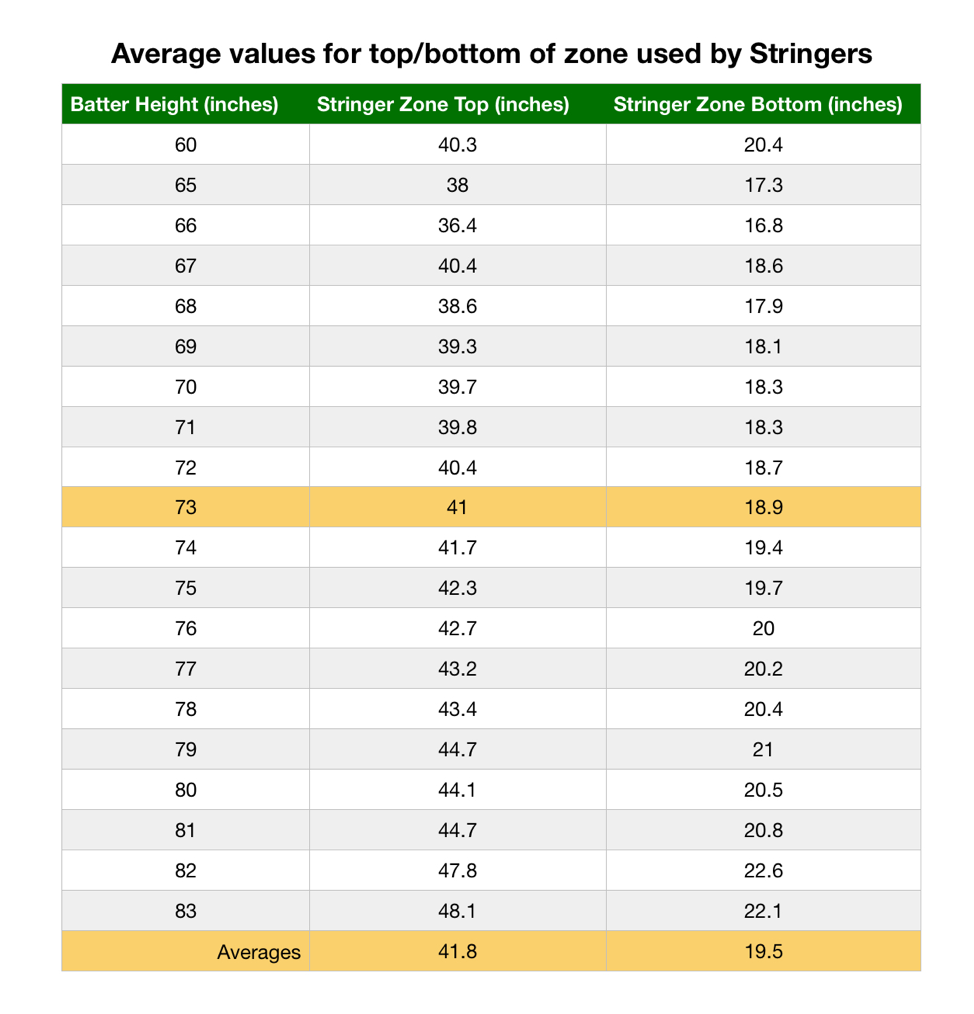
A Google search for “rulebook strike zone” reveals a comical range of images for interpretations of the rulebook strike zone. Some show a batter, but don’t even draw the midpoint at what is clearly the midpoint. Old strike zone rule examples from years ago before rule changes linger as well.
Official Rule 2.00: The Strike Zone
The STRIKE ZONE is that area over home plate the upper limit of which is a horizontal line at the midpoint between the top of the shoulders and the top of the uniform pants, and the lower level is a line at the hollow beneath the kneecap. The Strike Zone shall be determined from the batter’s stance as the batter is prepared to swing at a pitched ball.
Much of this disarray is because the rulebook strike zone is too subjective, ripe for interpretation. It will need a further refined definition to serve as a universal definition for postgame analysis, and also to help remove it as one of several major roadblocks for machine systems to be implemented calling balls and strikes in a live game.
For postgame analysis, there is no standard definition of the strike zone. That’s partly because most postgame analysis is done without the knowledge of each particular batter’s stance. In the absence of the batter’s stance information, analysts use a generic, “typical” batter strike zone, but each analyst has their own idea of the dimensions and location. Or they might use data of the top and bottom, which is set by MLB stringers. But stringers are people setting a top and bottom based on their subjective assessment, or they use pre-defined values obtained at some random time that may or may not be relevant to the player at the time of batting.
Stats for catcher framing, out-of-zone swing rate, in-zone swing rate, and several others depend on defining the batter’s strike zone. So comparing Analyst A’s stats with Analyst B’s stats aren’t necessarily a direct comparison. The analyst community needs to discuss and agree on a definition of a strike zone for the average batter for postgame analysis where the batter stance is unknown.
A postgame strike zone definition is so basic and fundamental to postgame data analytics that I find it amazing that this has yet to have an industry accepted standard definition. Once defined, that definition should then also be used to define a “universal” strike zone for game play, unifying both game play and postgame analysis.
Once a universal strike zone is defined, it would be used in game play as the same size and location for all batters. As it stands now, shorter batters have the advantage of a smaller strike zone, while taller batters are disadvantaged with a larger strike zone. A batter whose stance is more upright is disadvantaged compared to a batter who crouches over. Why do we need a different-sized zone for every batter and every particular stance a batter might use? It not only doesn’t make sense, but it severely complicates the use of machines and analysts’ stats, as well as training for pitchers, batters, and umpires.
Some have said that having a variable strike zone evens things out for shorter batters, taking away the supposed physical advantage of taller batters. That’s not a good argument. It’s as bad as if they were to make pitchers who threw faster pitch farther away from the plate to make things even for slower-throwing pitchers. It also assumes that a shorter batter is somehow disadvantaged. Jose Altuve would prove that idea false.
Before joining the Houston Astros, Mike Fast wrote for Baseball Prospectus that he saw just a small amount of difference in the top of the umpire-called strike zone for taller pitchers. So it appears that umpires are already using somewhat of a universal top of a strike zone.
Imagine the increase in consistency and accuracy there would be if pitchers, batters, and umpires all trained with the exact same strike zone 100 percent of the time. In addition, postgame analysis would match the game play, and stats would be consistent between each analyst.

The above is an example of postgame analysis of the balls and strikes called using a typical batter strike zone.
It’s a wonder why analysts are using so many of their own variations of a typical batter strike zone. Perhaps the reason for some of the confusion comes from the difference between what I call the “strike zone boundary” definition as in the rulebook strike zone definition, and the actual “true strike zone” due to the width of the ball. Then that confusion is compounded by dimensions of the “called strike zone” as called by umpires and also by MLB stringer values. This “called strike zone” is even more varied than what analysts use.
Under current MLB rules, the diameter of the ball shall be between 2.86 inches and 2.94 inches. For our purposes, we will use the larger value of 2.94 inches for the baseball width.
To clarify things, let’s define the five types of strike zones:
- Rulebook Strike Zone Boundary: This is the strike zone boundary dimensions and location drawn to the rulebook.
- True Strike Zone: This is the strike zone boundary dimensions and location drawn to the rulebook, with the added half-ball width added to the perimeter. Because if the center of the ball lands with half its width outside the strike zone boundary, the ball’s outer edge touches the zone. This is the strike zone that determines true balls and strikes. If the center of the ball is inside this zone, it is a strike.
- Called Strike Zone: This is the subjective strike zone to which umpires call balls and strikes.
- Stringer Strike Zone: This is the subjective strike zone set by video stringer operators for pro games.
- Universal Strike Zone: This is the strike zone boundary dimensions and location drawn to the rulebook for a typical 73-inch-tall player, with the added half-ball width added to the perimeter. Because if the center of the ball lands with half its width outside the strike zone boundary, the ball’s outer edge touches the zone. This is the universal strike zone used for postgame analysis when the batter height is not known. If the center of the ball is in this zone, it is a strike.
For example, Pitchgrader—my company that provides software to MLB and D-1 college teams to analyze and manage pitched/batted ball tracking data—uses this as a universal strike zone.
In the graphic below, the strike zone boundary is 17 inches wide, 19.76 inches bottom, and 42.61 inches top. The strike zone boundary is what you would use if creating a target for a pitcher to throw to. But the location where balls may land and touch those boundaries extends by half the width of a baseball for +1.47 inches around the perimeter. That’s the true strike zone for calling balls and strikes.

The above shows the universal strike zone used by Pitchgrader.
It seems many people try to define the strike zone for analysis based on how the umpires call the strike zone. Determining a universal strike zone based on what the typical umpire calls is a flawed approach because it’s a subjective strike zone. The same is true for using MLB stringer sz_top and sz_bot values, since they are also set by people making a subjective call of where the top and bottom of the zone was.
So using the subjective location of a ball determined by an umpire with an equally subjective strike zone boundary determined by a person manually setting stringer values is a recipe for inaccuracy, confusion, and the enigma we see now in what the strike zone actually is. The only way to determine an accurate and fair universal strike zone is to use the rulebook definition with actual body measurements of the mean average position player.
So let’s dig into how we decided to use these particular dimensions for the universal strike zone by looking at some key body measurement data.
A UCLA study lists 1,035 MLB players with heights and the average is 73.7 inches, but that includes all pitchers. However, if you exclude pitchers, this study has a mean average position player height of 72.81 inches and a median average height of 73 inches.
Anthropometric Data
Below are from a 2012 U.S. Army anthropometry study of 4,082 males. The average height of these males for the 1st percentile group was 62.99 inches, which is considerably shorter than a typical 73-inch male baseball player. For 73 inches (72.60 inches), that was the 90th percentile group in this study. So we will use the 90th percentile group.
Height
Height is 62.99 inches for the 1st percentile and 72.60 inches for the 90th percentile (page 193).

Hollow Below Knee
Tibial height (below knee cap) is 16.06 inches for the 1st percentile and 19.76 inches for the 90th percentile (page 205).

Top of Shoulders
Acromial height (top shoulder) is 51.02 inches for 1st percentile and 59.88 inches for 90th percentile group (page 47).

Pants Top
Pants top at midpoint between waist height (belly button) and buttock height. This is 37.52 inches + (44.21 inches – 37.52 inches)/2 = 40.86 inches.
Waist height, belly button (page 223) is 37.13 inches for 1st percentile group and 44.21” for 90th percentile group.
Buttock height (page 79) is 30.71 inches for 1st percentile group and 37.52 inches for 90th percentile group.




So midpoint between the shoulders and the top of the uniform pants, from the ground is ((59.88 inches – 40.86 inches)/2) + 40.86 inches = 50.21 inches. Then we have to subtract the typical shoulder drop when in the batting stance of 7.6 inches. That puts the top of the zone at 50.21 inches – 7.6 inches = 42.61 inches.
Batting Stance Shoulder Drop
Since batters hunch over slightly in their stance, a slight bend at the waist plus slight bending of the knees lowers the shoulder height. This shoulder drop averages about 7.6 inches as noted in the following images.
Assorted batter standing vs stance ratios:
Compared to the average 73-inch MLB position player, Aaron Judge is six inches taller and Jose Altuve is seven inches shorter. If we use these two MLB batter height extremes and examine their stances, we get shoulder drops of 7.11 inches for Aaron Judge and 8.58 inches for Jose Altuve, which averages to a shoulder drop of 7.58 inches.
Stance Ratio
At Pitchgrader, we use what we call the “stance ratio,” which we define as the ratio between the player’s head height when in his batting stance divided by head height when standing normally. Then take the same ratio using the player’s shoulder instead of head. Then average the two ratios, rounding to two decimal places.
Aaron Judge: A rough measurement looks like he has a 0.91 stance ratio. Since he’s 6-foot-7 (79 inches), that would mean his shoulder lowers when in batting stance about 79 inches – (79 inches x 0.91) = 7.11 inches.


Jose Altuve: A rough measurement looks like a 0.87 stance ratio. Since he’s 5-foot-6 (66 inches), that would mean his shoulder lowers when in a batting stance about 66 inches – (66 inches x 0.87) = 8.58 inches.


Typical Analyst Zones
Examples of various analysts’ postgame analysis strike zones are as follows:

From the table above, you might be tempted to think, well, the average zone top and width seem to roughly agree, so why not use the average zone bottom? Many analysts are using a zone bottom that’s 2-5 inches higher. That’s part of the problem, as we should be defining the zone based on the actual batters and rulebook strike zone, not what analysts, stringers, or umpires guess.
Stringer Zones

So what emerges is a possibility as to why some analysts use the top and bottom of the zone that they use. It looks like they possibly used a simple mean average of the stringer values. That would not be a valid “typical batter” because it values the 60-inch and 83-inch height extremes of players the same as the majority of the typical 73-inch batters.
It seems as though analysts also might have chosen the dimensions they use in order to somewhat agree with what the stringers average values are, and what the umpire’s typical called strike zone is. I also can’t see a reason to justify a zone width other than 19.94 inches when the plate is always 17 inches wide and ball is always 2.94 inches in diameter. Their zone top seems to be almost arbitrarily chosen. The zone bottom they use seems to follow how umpires tend to call the bottom of the zone, but it’s not the true bottom of the zone.
Universal Strike Zone Definition
Based on the analysis of the anthropometric data of the average MLB position player, while staying true to the rulebook strike zone definition, the universal strike zone should be defined as below:
Universal Strike Zone Bottom: 18.29 inches
Based on anthropometric data, there can be little argument against using tibial height of 19.76 inches minus 1.47 inches for half a ball width = 18.29 inches for the bottom of the universal strike zone.
Universal Strike Zone Width: 19.94 inches
The width of the zone should be indisputable. The plate is 17 inches wide, and the maximum allowable tolerance for a baseball is 2.94 inches. So half of a ball width on each side of the plate produces a universal strike zone width of 19.94 inches.
Universal Strike Zone Height: 44.08 inches
Based on the anthropometric study cited, the top of the strike zone boundary would be 42.61 inches, which accounts for the reduction of height by the average amount of waist and leg bending when in the batting stance. Then you still have to add 1.47 inches for half a ball width for the universal strike zone top for 44.08 inches.
With the wide range of postgame strike zone dimensions and locations used by various analysts, the stats for catcher framing, O-swing, Z-swing, and others that depend on defining the strike zone, it’s like comparing apples to baseballs. They don’t match up.
The universal strike zone definition is so basic and fundamental to postgame data analytics that it requires an industry accepted standard definition. That definition should then be used for game play as a universal strike zone for all batters, unifying both game play and analysis.
Wayne Boyle is an electronics and software engineer with a career spanning 30 years. He is the founder of Pitchgrader, which makes advanced software used by top D1 & MLB teams for Pro level baseball 3D analysis/simulation/projection, and actionable meaning for pitched and batted ball tracking data for player development and scouting.
Thank you for reading
This is a free article. If you enjoyed it, consider subscribing to Baseball Prospectus. Subscriptions support ongoing public baseball research and analysis in an increasingly proprietary environment.
Subscribe now
The Universal Strike Zone bottom is 18.29” , so Altuve would have his zone bottom raised by 1.1” , and Judge lowered by 1.3”.
For the batters, this isn’t much to have the bottom adjusted by less than 1.5” , roughly less than half a baseball width, but it would be a big advantage for post game analytics and the Robo zone.
Well then why don't we get cracking on it. I know when I'm watching Jose Altuve or Aaron Judge bat I'm thinking "Man, it's pretty cool watching some of the best players in baseball perform an almost superhuman task, but what I REALLY want to see are pundits discussing consistent postgame analytics."
As for fairness, an inconsistent strike zone isn’t fair to the pitcher or batter. For advance scouting reports, having to analyze a particular umpire’s called zone so that you can match up with a pitcher that is more favorable to his zone is something that shouldn’t be needed either. The umpire is then a part of the game, instead of just ensuring that the strike zone and rules are followed.
(b) Is not struck at, if any part of the ball passes through any part of the strike zone;"
So, theoretically, if one stitch of the baseball (the outer edge of the baseball) passes through the strike zone, the pitch is a strike. Hence, the strike zone should be 22.88 inches wide, should it not?
Suppose you defined it by height. Every player has his height measured to, say, a half inch, and the bottom and top are defined with reference to that. Judge gets a wider zone than Altuve, and two players of the same height get the same zone.
That should be a fairly easy to implement variation on your proposal, and it's a heck of a lot fairer.